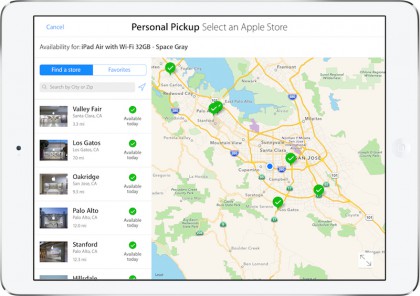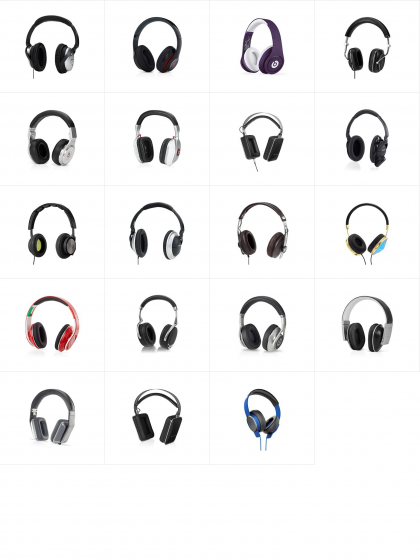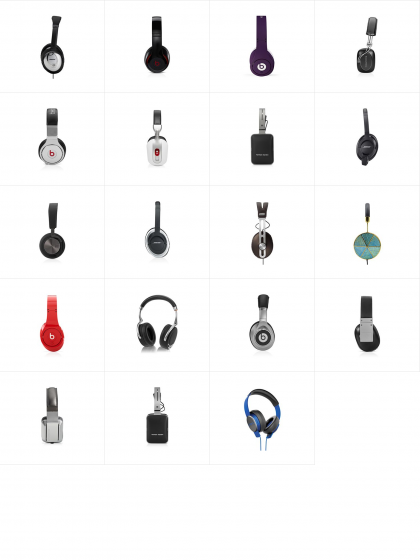NBA relies on iPad ∞
Quite an embarrassment for Samsung considering the NBA just signed $100 million deal with them to use their tablets.
Quite an embarrassment for Samsung considering the NBA just signed $100 million deal with them to use their tablets.
The only thing Google didn’t do is change their name to Samsung.
Another very nice looking, easy to use app that was updated today.
Apple on Wednesday released a new app for the iPad: Apple Store. The new app gives users ability to make purchases of Apple products and third-party accessories in an app designed specifically for the iPad.
Apple Store for iPad allows you to shop for Mac, iPad, iPhone and iPod, as well as the accessories you would expect to find for those products. After purchasing a product, you can choose to have it shipped to you or you can pick it up at your nearest retail location.

While shopping, you can filter the results very easily to see only the types of products you want. For instance, if you are looking at headphones and only want to see over-the-ear models, you can filter out all other results. If you pinch on the results, the grid gets larger, showing you more headphones at a glance. In true Apple attention to detail, if you swipe one set of headphones, it will turn sideways—then all of the headphones on the page will also turn sideways giving you a different view of the product.


There are many other things you can do with the app as well, like engraving, gift wrapping and checking the availability of products in your local store.
This is a great shopping experience. Apple Store for iPad is free to download from the App Store.
Fascinating review offers insight into the design tradeoffs involved in being first to market with a new technology.
Jason Biheller, the director of gaming innovations at PowerA, admitted that some of the issues with the controller’s feel may have been due to a number of restrictions. “It wasn’t an easy project,” he said in a phone interview. “I’m not blaming this on timing, but we did have a limited amount of time to get this done, and because the phone had to sit in the middle, it was very difficult. I guess you lose a little stability by having the phone in the center of the controller, because you’ve got moving parts and some mechanical designs moving back and forth. So you lose some of that solid feel you get with the Vita.”
I see three obvious alternatives to game controller design. First is the sandwich, the approach taken by Moga and Logitech (with their PowerShell controller), with the controller built to sandwich the iOS device between the two sides of the controller. This seems to be the most efficient approach if you want to take the controller with you, but has the mechanical disadvantage of having two points of wiggle weakness or flex, where the controller connects to the iOS device.
The second alternative is the top-heavy approach used for most Android controllers, where the device is held in place on top of the controller. This approach is unwieldy but necessary, due to the large number of Android form factors.
The third approach, is the satellite design used by consoles, where the controller is a single, solid, piece and plugs into the device via a cable. The upsides are solid controller feel and compatibility with multiple form factors (iPad and iPhone, for example), while the down side is the clumsiness of play while on the move.
It’s early days and I’m sure there’ll be lots of design innovation to come.
Wow. Bad bet.
Elon Musk responds to the horrendous media overreaction to 3 Tesla S fires. Well done.
Not a fan of Bob Dylan? Doesn’t matter. Click the link, watch for 10 seconds, then change the channel. Don’t get what’s happening? Keep changing the channel. Incredible. I would love to see a “behind the scenes” on the making of this.
Congrats, Selfie, I hope this makes you feel good about yourself.
Adam Najberg shares his initial thoughts on the Xbox One. If you are planning on buying an Xbox One or have one on preorder, this is well worth a read. More importantly, I think anyone involved in the gaming space, especially on the hardware side, might take a look as well. There are lessons to be learned.
Apart from a dearth of titles — the Xbox One is launching with 23 games — my main beef with the Xbox One is that games take longer than I want to download, because of their large size and my relatively slow 30 Mbps Internet connection.
Thankfully, games let you start playing well before they’re fully downloaded, and keep downloading in the background until they’re done. And there aren’t enough games that allow you to skip over cinematic scenes. I’m hoping developers and publishers get less self-impressed and let us get to the gameplay faster as fascination with the new consoles’ capabilities diminishes.
One quibble. I get that 30 Mbps is not the fastest connection available, but I would hardly qualify it as relatively slow. Not picking on the author, just making the point that if an experience is a problem at 30 Mbps, it’s a problem for a large slice of your audience.
After laying hands on both consoles, though, I can see where Microsoft and Sony have diverging views of the future and what role your living room will play in it.
Sony has coalesced around the gaming community, trying to grab gamers in an even tighter embrace than ever before.
Microsoft is looking to breed total dependence for games, social media, communications and entertainment through one device. The hope is that gamers who cut their teeth on the Xbox 360 will still gravitate toward the Xbox One and its enhanced multiplayer gaming. Now, though, there’s a whole new, younger and more-easily-distracted generation of gamers coming online, the kids with their smartphones or iPad Minis in their lap as they play, chatting, listening to music or watching a video. With Xbox One, Microsoft is hoping to move their second screen onto the first screen.
It’ll be interesting to watch all this play out. To me, this Microsoft and Sony, burning their powder trying to fine tune their console-based living room experience while Nintendo frets on the sidelines and Apple and Google plot their longer view. Such fun.
RiffRumble Metal is over and the winners have been announced. I had the honor of choosing the first place winner this year and it was a really difficult decision. Congrats to the winners.
I love apps that do one thing and do it really well. This looks great.
This is great… and accurate.
Following up on Michael Lopp’s “Stagnation” story posted earlier today, Daniel Jalkut give us his thoughts.
But what really frustrates me in this case is the software has served him perfectly, and he thanks it with a slap to the face. It’s one thing to denigrate a product for failing to meet your expectations, or for exhibiting a clear lack of craftsmanship, but Lopp admits that those problems do not apply.
I used to write with fountain pens all the time. I still have a couple, but I don’t use them much anymore.
This is when you know it’s time to get a new app.
BBC News:
All of the surviving members of comedy group Monty Python are to reform for a stage show, one of the Pythons, Terry Jones, has confirmed.
For many of us “of a certain age”, this makes us squeal with delight.
A new Web site from Shawn Blanc where he recommends the best app in each category. Seems to be like The Wirecutter, but for Apple. I like the idea of having a site that will take a stand and give out their recommendation.
Apple added two new stations to the Apple TV on Tuesday: PBS and Yahoo Screen. The PBS station will feature primetime shows, including Downton Abbey. The shows will be available on Apple TV a few hours after they air live. Yahoo Screen will feature clips from Saturday Night Live, The Daily Show, and others, as well as original Yahoo programming.
I can definitely see how this would be useful. I like the look of the templates too—that’s a nice idea.
Superior Drummer is one of my favorite drum samplers on the market. This new expansion pack was recorded at The Warehouse Studio by Randy Staub (Metallica’s “Black Album”, Nickelback’s “Silver Side Up”, Avril Lavigne’s “Under My Skin”), so you know it’s going to sound good.
This is an important step in Apple’s move to expand their reach into the gaming universe.
The MOGA Ace Power iOS game controller requires an iPhone with a lightning port. It includes a battery pack, so you can charge your iPhone while you play (or at least limit the drain on your iPhone’s battery).
Interesting that all the buttons are analog.
The biggest initial surprise of the MOGA Ace Power is that nearly all of the buttons are analog. Following rumors, and just how controllers typically work, I think we all expected the only analog controls to be the actual dual analog sticks themselves and maybe the outmost triggers. It turns out all of the buttons are analog. All of the triggers, the face buttons, even the D-Pad. In fact, the only non-analog gaming control on the whole thing is the pause button.
Unfortunately, as with all early adopter technologies, this device is ahead of developer testing cycles.
However, with surprise comes disappointment, and the main source of that disappointment is how incredibly obvious to us that all of the developers out there releasing updates to add iOS 7 controller support are doing so without actually testing on a controller. For instance, Dead Trigger 2 [Free] comes with default sensitivity settings that were so high there’s no way any human could play that way. Similarly, LEGO Lord of the Rings [$4.99] has controller support, but you can only move using the D-Pad, not the analog stick. Strange little inconsistencies like that are everywhere, and I’ve yet to find a game that recognizes analog button presses.
I expect this will change as developers get their hands on the controller. I can’t wait to get my hands on one.
Thinking of taking advantage of Apple’s Reuse and Recycling program? You now have the option of trading in a water-damaged iPhone or iPad. If you’ve never been to the site, take a minute to dig into the options. Interesting to see the range of devices Apple will take in trade. To Apple’s credit, even if your device has no value, Apple will send you a shipping label so you can return the device to Apple and keep it out of the landfill.
Have a Windows machine? No problem. Apple will take trade-ins on some models. And for those machines Apple can’t repurpose, they’ll point you to a free recycling solution.
Would be nice to see this in a museum somewhere. The opening bid was set at €180,000 (about US$243,000), which is relatively low compared to recent bids for a working Apple I. Goes to show how tricky the classic computer market can be.
This video is a couple of years old, but new to me. Filmed off the west coast of the South Island of New Zealand, near Greymouth. Fantastic footage. Riveting.
Paula Borowska put together a guide for creating iOS 7 icons.
Universal Audio released two new plug-ins on Monday: the Maag EQ4 and the Classic Fairchild 660 and 670 Tube Limiters. I love the Fairchild—can’t wait to get my hands on these.
Alex Vollmer takes you through one of the most classic solos of all time. I love playing this Jimmy Page solo.
As part of a settlement announcement on Monday, Google has agreed to pay out $17 million to 37 U.S. states, as well as the District of Columbia, for ignoring anti-tracking protocols baked in to Apple’s Safari Web browser.
I’m willing to bet they made a lot more than $17 million.